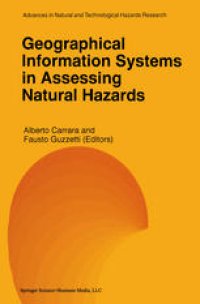
Ebook: Geographical Information Systems in Assessing Natural Hazards
- Tags: Hydrogeology, Data Structures Cryptology and Information Theory, Environmental Management, Earth Sciences general, Geoengineering Foundations Hydraulics
- Series: Advances in Natural and Technological Hazards Research 5
- Year: 1995
- Publisher: Springer Netherlands
- Edition: 1
- Language: English
- pdf
The 16 contributions to Geographical Information Systems in AssessingNatural Hazards report on GIS investigations into landslides, floods, volcanic eruptions, earthquakes and groundwater pollution hazards. Current methods for predicting extreme events are critically discussed, the emphasis being on the intrinsic complexity of this type of operation, requiring many spatial data, long historical records and sound models of the physical processes involved. Within this context, the potentials and limitations of GIS are addressed in terms of data acquisition, spatial data structures and modelling for simulation of the causal phenomena.
Geographic Information Systems in Assessing Natural Hazards will help investigators in both public and private institutions to evaluate the actual effectiveness of GIS in coping with natural disasters, and to develop new strategies for projects aimed at the assessment and mitigation of the effects of such catastrophic events.
The 16 contributions to Geographical Information Systems in AssessingNatural Hazards report on GIS investigations into landslides, floods, volcanic eruptions, earthquakes and groundwater pollution hazards. Current methods for predicting extreme events are critically discussed, the emphasis being on the intrinsic complexity of this type of operation, requiring many spatial data, long historical records and sound models of the physical processes involved. Within this context, the potentials and limitations of GIS are addressed in terms of data acquisition, spatial data structures and modelling for simulation of the causal phenomena.
Geographic Information Systems in Assessing Natural Hazards will help investigators in both public and private institutions to evaluate the actual effectiveness of GIS in coping with natural disasters, and to develop new strategies for projects aimed at the assessment and mitigation of the effects of such catastrophic events.
The 16 contributions to Geographical Information Systems in AssessingNatural Hazards report on GIS investigations into landslides, floods, volcanic eruptions, earthquakes and groundwater pollution hazards. Current methods for predicting extreme events are critically discussed, the emphasis being on the intrinsic complexity of this type of operation, requiring many spatial data, long historical records and sound models of the physical processes involved. Within this context, the potentials and limitations of GIS are addressed in terms of data acquisition, spatial data structures and modelling for simulation of the causal phenomena.
Geographic Information Systems in Assessing Natural Hazards will help investigators in both public and private institutions to evaluate the actual effectiveness of GIS in coping with natural disasters, and to develop new strategies for projects aimed at the assessment and mitigation of the effects of such catastrophic events.
Content:
Front Matter....Pages i-xii
A Survey of the Field of Natural Hazards and Disaster Studies....Pages 1-19
Gis and Natural Hazards: An overview from a Gis Perspective....Pages 21-34
Vector and Raster Structures in Generating Drainage-Divide Networks from Digital Terrain Models....Pages 35-55
Deterministic Modelling in Gis-Based Landslide Hazard Assessment....Pages 57-77
Determining Paths of Gravity-Driven Slope Processes: The ‘Vector Tree Model’....Pages 79-92
Statistical and Simulation Models for Mapping Debris-Flow Hazard....Pages 93-106
Multivariate Regression Analysis for Landslide Hazard Zonation....Pages 107-133
Gis Technology in Mapping Landslide Hazard....Pages 135-175
Flood Delineation and Impact Assessment in Agricultural Land Using GIS Technology....Pages 177-198
The Role of GIS as A Tool for the Assessment of Flood Hazard at the Regional Scale....Pages 199-217
GIS Technology for the Design of Computer-Based Models in Seismic Hazard Assessment....Pages 219-233
GIS-Aided Volcanic Activity Hazard Analysis for the Hawaii Geothermal Project Environmental Impact Statement....Pages 235-257
GIS Potential for Regional and Local Scale Groundwater Hazard Assessment....Pages 259-272
Application of GIS to Hazard Assessment, with Particular Reference to Landslides in Hong Kong....Pages 273-298
The San Mateo County California Gis Project for Predicting the Consequences of Hazardous Geologic Processes....Pages 299-334
GIS Used to Derive Operational Hydrologic Products from in Situ and Remotely Sensed Snow Data....Pages 335-342
Back Matter....Pages 343-355
The 16 contributions to Geographical Information Systems in AssessingNatural Hazards report on GIS investigations into landslides, floods, volcanic eruptions, earthquakes and groundwater pollution hazards. Current methods for predicting extreme events are critically discussed, the emphasis being on the intrinsic complexity of this type of operation, requiring many spatial data, long historical records and sound models of the physical processes involved. Within this context, the potentials and limitations of GIS are addressed in terms of data acquisition, spatial data structures and modelling for simulation of the causal phenomena.
Geographic Information Systems in Assessing Natural Hazards will help investigators in both public and private institutions to evaluate the actual effectiveness of GIS in coping with natural disasters, and to develop new strategies for projects aimed at the assessment and mitigation of the effects of such catastrophic events.
Content:
Front Matter....Pages i-xii
A Survey of the Field of Natural Hazards and Disaster Studies....Pages 1-19
Gis and Natural Hazards: An overview from a Gis Perspective....Pages 21-34
Vector and Raster Structures in Generating Drainage-Divide Networks from Digital Terrain Models....Pages 35-55
Deterministic Modelling in Gis-Based Landslide Hazard Assessment....Pages 57-77
Determining Paths of Gravity-Driven Slope Processes: The ‘Vector Tree Model’....Pages 79-92
Statistical and Simulation Models for Mapping Debris-Flow Hazard....Pages 93-106
Multivariate Regression Analysis for Landslide Hazard Zonation....Pages 107-133
Gis Technology in Mapping Landslide Hazard....Pages 135-175
Flood Delineation and Impact Assessment in Agricultural Land Using GIS Technology....Pages 177-198
The Role of GIS as A Tool for the Assessment of Flood Hazard at the Regional Scale....Pages 199-217
GIS Technology for the Design of Computer-Based Models in Seismic Hazard Assessment....Pages 219-233
GIS-Aided Volcanic Activity Hazard Analysis for the Hawaii Geothermal Project Environmental Impact Statement....Pages 235-257
GIS Potential for Regional and Local Scale Groundwater Hazard Assessment....Pages 259-272
Application of GIS to Hazard Assessment, with Particular Reference to Landslides in Hong Kong....Pages 273-298
The San Mateo County California Gis Project for Predicting the Consequences of Hazardous Geologic Processes....Pages 299-334
GIS Used to Derive Operational Hydrologic Products from in Situ and Remotely Sensed Snow Data....Pages 335-342
Back Matter....Pages 343-355
....